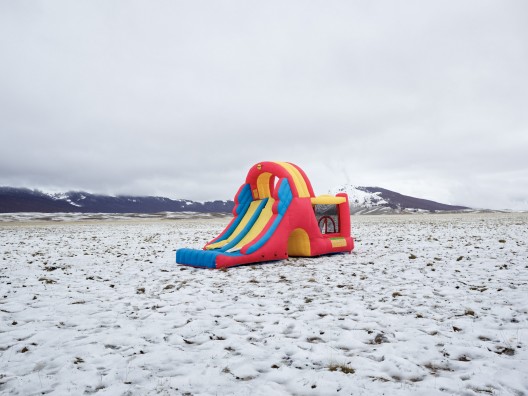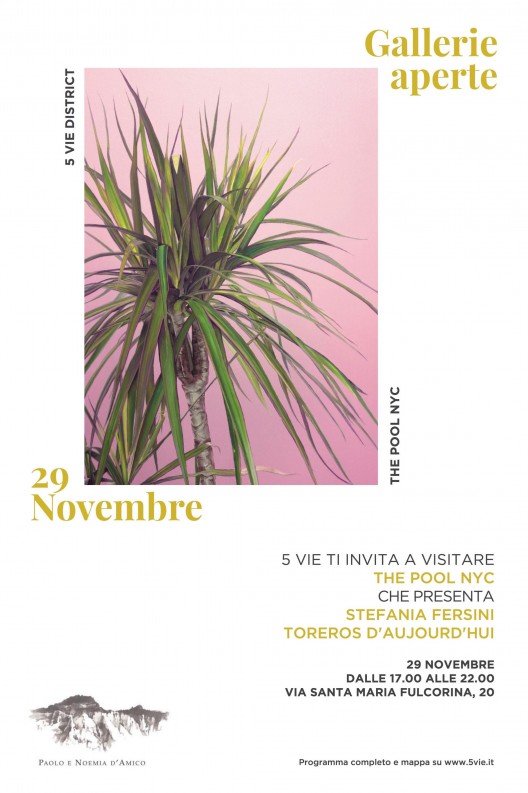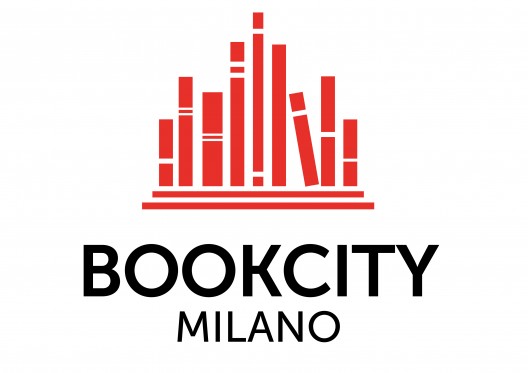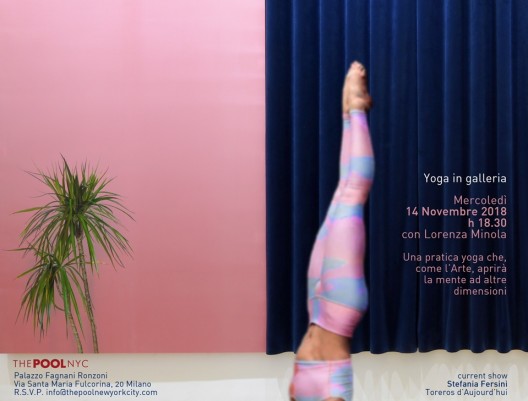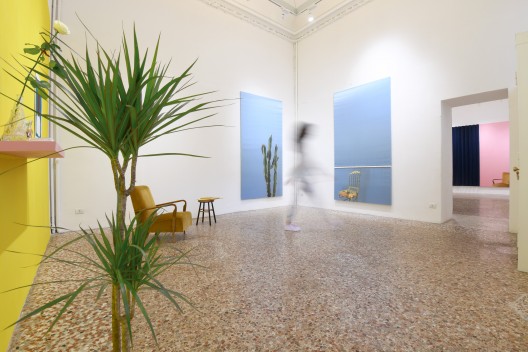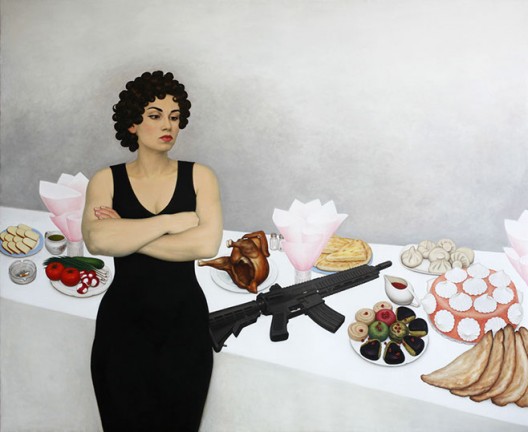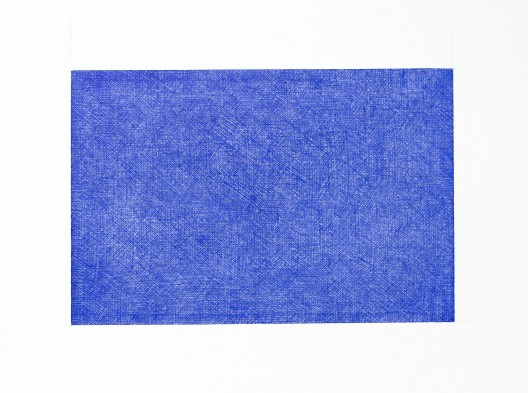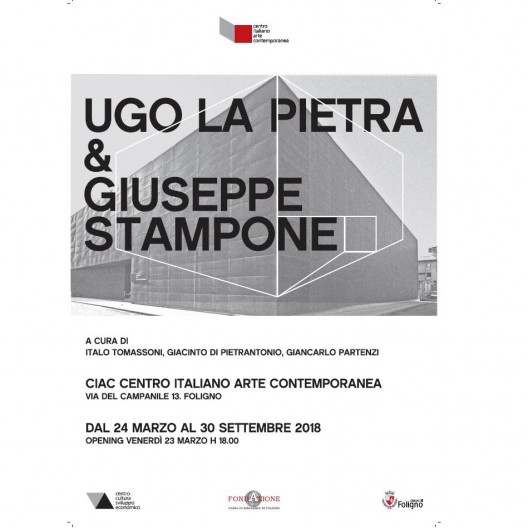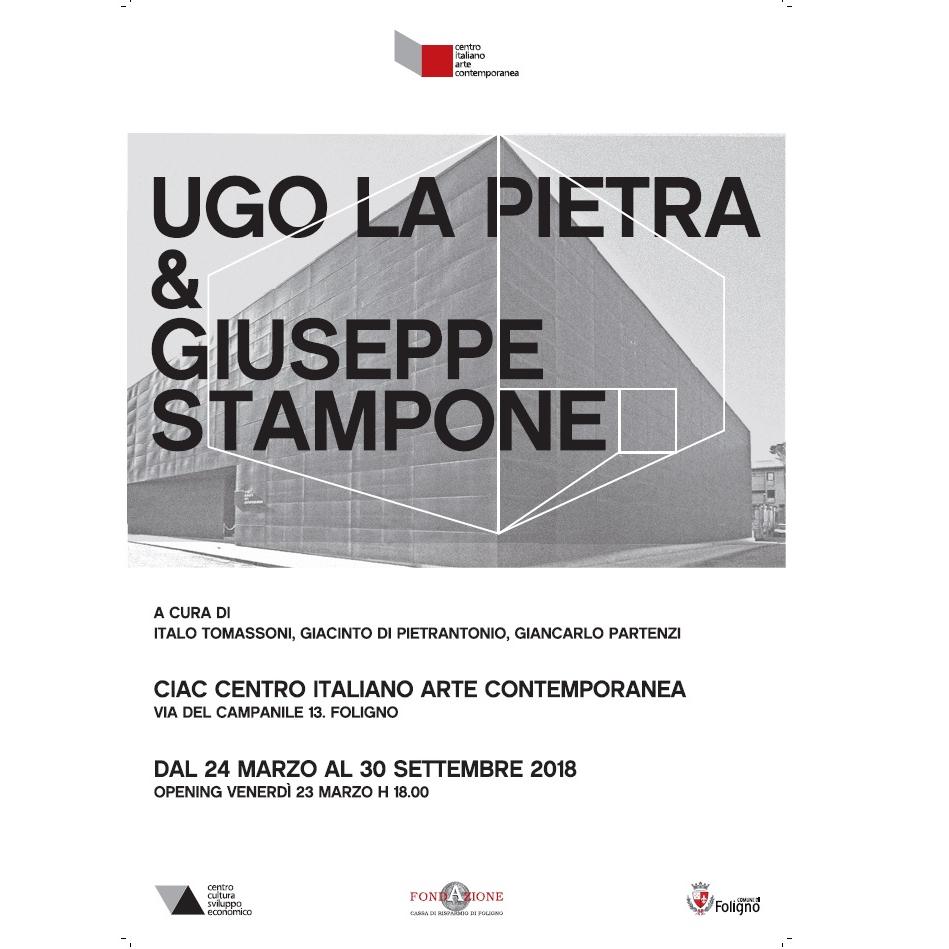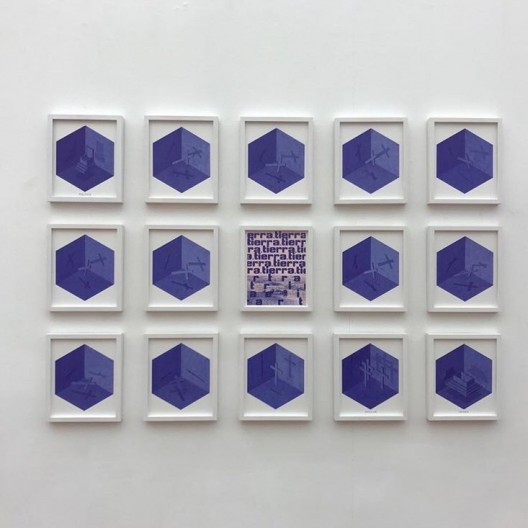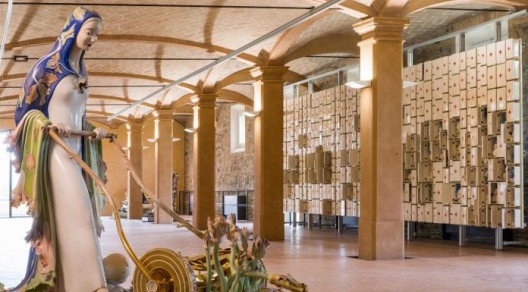24 JANUARY / 23 MARCH 2019
THE POOL NYC is proud to present Aquila, a solo exhibition by Stefano Cerio with a special guest: Giuseppe Stampone, from Abruzzo.
The exhibition is a tribute to Abruzzo and the areas hit by the terrible earthquake in 2009.
Stefano Cerio has installed an inflatable house in a poetic attempt to create a fictitious reconstruction of the area.
The artist has already portrayed places such as water parks, ships cruise, or luna parks that, as for the inflatable house, are supposed to be icons/models of entertainment. These places have been photographed when closed, without people, and are brilliant portraits of an absence. It’s the missing people that makes these places even more surreal.
In the Aquila series there is an evolution: it is no longer the place to be surreal, yet the final effect obtained by placing an inflatable house in a context where it does not belong.
Photography is used to document an installation, a performance. The natural spot takes on a different meaning, with the temporary inflatable house that suddenly becomes almost metaphysical object. The inflatable house is, by nature, anti-seismic, and Cerio’s gesture can be considered a act of faith. In fact, a good portion of the region affected by the drama, has not been completely reconstructed. With this project the artist aspires to rebuild it ideally.
The inflation of the house has been documented by a video, which becomes a proper performance. The whole process of inflation and deflation, a metaphor of birth and collapse, is an attempt to represent a sort of new life in a territory where it is not anymore.
Stefano Cerio focuses on natural landscapes, without constructions, where there was no loss at all. In Campo Imperatore, near L’Aquila, nothing, but bare ground, could collapse.
The very deep intent of the artist is to create a new town in the middle of nowhere, giving hope to the people thanks to the playful objects spread around.
Cerio is releasing a work with a social logic, but without any rhetoric because “Rhetoric is the absolute enemy of contemporary art”.
The exhibition also features a native artist from Abruzzo, to whom the theme is very dear: Giuseppe Stampone. He wanted to pay a tribute to his region with some significant works that would complete the project conceived by Cerio.
OPENING RECEPTION, THURSDAY, JANUARY 24TH, 6-9 PM
Giovedì 29 Novembre nel quartiere delle 5 Vie di Milano, le gallerie d’arte rimarranno aperte fino alle 22.
In occasione dell’apertura straordinaria, durante la mostra personale “Toreros d’Aujourd’hui” di Stefania Fersini, la galleria THE POOL NYC ospita il curatore Maurizio Bortolotti con un talk sull’arte contemporanea in Cina.
Vi Aspettiamo a Palazzo Fagnani Ronzoni, in Via Santa Maria Fulcorina, 20.
Gli scaffali interiori – vedersi vedere. Arte visiva e incursioni letterarie
Domenica 18 Novembre 2018 alle 18.30 presso THE POOL NYC
Con Gianluigi Ricuperati, Federica Giallombardo e Stefania Fersini
Negli spazi della galleria THE POOL NYC, Ricuperati e Giallombardo parleranno di arte contemporanea alla presenza dell’artista Stefania Fersini e verrà illustrato il libro “Inner Shelf”.
Sarà possibile visitare la mostra personale di Fersini e confrontarsi con l’artista e la curatrice Viola Romoli.
#BCM18
YOGA at the GALLERY! Every Tuesday!
Please, get in touch with the gallery for info and reservations.
Una pratica Yoga che, come l’Arte, aprirà la mente ad altre dimensioni.
Vi aspettiamo per una lezione di yoga in galleria.
La Galleria, un luogo diverso, ispirante, dove tutte le energie positive, grazie alla pratica yoga, confluiranno a favore di mente e corpo.
11 November- 21 December
The world is full of objects, more or less interesting; I do not wish to add any more.
I prefer, simply, to state the existence of things in terms of time and/or space.
Douglas Huebler
In Palazzo Fagnani Ronzoni, THE POOL NYC presents Toreros d’Aujourd’hui, Stefania Fersini’s first solo exhibition in Milan. Describing Stefania Fersini’s (Aosta, 1982) brave meta-artistic and post-curatorial work, is an act of equal critical and narrative braveness. However, this young artist has already demonstrated an extreme elusive pictorial quality, playing with the enigma of recognition – of herself, of others – and with real and imaginary space conceptions. Mansions and historical palaces transformed with works as Mirror (Casa Mollino, Turin) and Vanitas (Palazzo Reale, Milan), are just two out of many examples.
For this particular installation – special, for every ascent is determined by growing risk – Fersini puts into effect her mimesis with the exhibition space, a slight repetition of the artist in others’s masterpieces; a process of fragmentation of herself in other artists works; a scenographer and editor awareness; a theatrical direction of an absent work.
In fact, Toreros d’aujourd’hui transforms Palazzo Fagnani Ronzoni, THE POOL NYC gallery’s exhibition site, in the same work presented by Fersini. A place that becomes etymologically domestic, home of pastel colours and innovative materials; a space that gets to a continuous déjà vu of partially and peripherally painted curtains and tapestries, with fictitious furnishings and paintings, playing in between expectations and reality, background and subject.
Actually, the “house” created by the artist is made of many works – both old and new, because time is a factor to keep in mind at every step in the labyrinthine reasoning – by Aldo Mondino, Hilario Isola and Gabetti and Isola: Fersini is omnipresent, working at the same time as a frame and a container for the above-mentioned works, suddenly revealing herself while keeping her typical elusivity. The subject represented in this work is connected to the work itself while being located in a different place. The subject, chosen by Fersini, is not in front of the canvas that could represent it, yet – maybe – in another room. The space between the object and its representation, the aesthetics of the observer’s deception by an omniscient and ironic narrator: the experience of the exhibition is in itself the work – indeed, the meta-work. Finally, this experience is intimately connected to the biography of the artists, in a continuous genealogical exchange between preceptors and successors; a genetic and hereditary relationship – Hilario Isola, as a matter of fact, plays his father’s intellectual legacy with his Aristotele. The exhibition’s name itself comes from a book by Aldo Mondino, specifically chosen for this occasion by her son Antonio.
With some clue-phrases from other authors – embroidered and painted with his calligraphy – Fersini calls out fathers and sons to an artistic and genetic dialogue of memes, in a framework made out of memories and references between space and time, guaranteeing extraordinary powers of wondering, attraction, inquiry and universality.
Federica Maria Giallombardo
Il mondo è pieno di oggetti, più o meno interessanti; non voglio aggiungerne altri. Preferisco, semplicemente, affermare l’esistenza delle cose in termini di tempo e/o spazio.
Douglas Huebler
Nelle sale di Palazzo Fagnani Ronzoni THE POOL NYC presenta Toreros d’Aujourd’hui, la prima mostra personale di Stefania Fersini a Milano. Descrivere l’audace impresa meta-artistica e post-curatoriale di Stefania Fersini (Aosta, 1982) è un atto di altrettanta arditezza critica e narrativa. Del resto, la giovane artista già ha dimostrato una qualità pittorica elusiva estrema, che gioca con l’enigma del riconoscimento – di sé, degli altri – e della concezione dello spazio reale e immaginario – si pensi alle dimore e ai palazzi storici trasformati grazie a opere come Mirror (Casa Mollino, Torino) e Vanitas (Palazzo Reale, Milano).
Per questa singolare installazione – particolare, perché ogni ascesa è determinata da un rischio maggiore – Fersini attua la sua mimesi con lo spazio espositivo in senso stretto: un ripetersi sottile in ogni capolavoro altrui; una frammentazione di sé negli altri; una consapevolezza da scenografa e curatrice; una regia teatrale di un’opera assente, plasmata di vuoti quanto di quotidiani. Infatti, Toreros d’aujourd’hui trasforma Palazzo Fagnani Ronzoni, sede espositiva della galleria THE POOL NYC, nella stessa unica opera di Fersini presentata. Un luogo che diventa etimologicamente domestico, alcova di tinte pastello ed elementi riconoscibili; uno spazio che diviene un perpetuo déjà vu di tende e tappezzerie dipinte parzialmente e in maniera periferica, con mobili e quadri fittizi, che gioca sull’ambivalenza di aspettativa e realtà, sfondo e soggetto, margine e protagonismo. Effettivamente, la “casa” ideata dall’artista è composta da alcuni lavori – vecchi e nuovi, e il fattore tempo è da tenere presente a ogni passo nel labirintico ragionamento – di Aldo Mondino, Hilario Isola e Gabetti e Isola: Fersini è onnipresente, facendo da cornice e da contenitore delle opere dei suddetti, svelandosi a tratti e ricreando la costante elusività che la rappresenta. Ciò che viene rappresentato sull’opera sarà un oggetto legato all’opera stessa e dislocato in spazi diversi. L’oggetto, selezionato da Fersini, non si troverà davanti alla tela che lo potrebbe raffigurare, ma in un’altra stanza. La ricerca, nello spazio, dell’armonia dell’esposizione e della riflessione; lo scampolo tra l’opera reale e quella riprodotta; l’estetica dello scacco dell’osservatore da parte di una narratrice onnisciente e ironica: l’esperienza della mostra è di per sé l’opera – anzi, la meta-opera.
Si aggiunga infine che l’esperienza è intimamente connessa a quella biografica degli artisti, in un continuo scambio genealogico tra precettori e successori; una relazione genetica e artisticamente ereditaria – Hilario Isola, ad esempio, interpreta il lascito intellettuale del padre con il suo Aristotele. Persino il titolo della mostra deriva dal nome di un libro appartenuto ad Aldo Mondino, appositamente scelto da suo figlio Antonio per questa occasione. Con le frasi-indizi di altri autori – ricamate e dipinte con la sua calligrafia – Fersini invita padri e figli a un dialogo artistico e genetico di memi, in un teatro di ricordi e rimandi tra spazio e tempo, garantendo straordinari poteri di meraviglia, attrazione, interrogazione e universalità.
Federica Maria Giallombardo
THE POOL NYC is proud to present Gaumarjos the first solo exhibition by Eteri Chkadua in Milan. After representing Georgia at the Venice Biennial in 2007 Eteri Chkadua has been exhibited in several museums around the world. Eteri’s work has been included in many exhibitions organized by the gallery in Mexico City, Venezia, Roma, New York, Hong Kong, and Bologna. This is her second solo show organized by THE POOL NYC in Italy.
Among Georgians Gaumarjos, meaning “Victory to you”, is the everyday way of saying Cheers. At every banquet, every guest will have to say Gaumarjos for someone or something when the wine-filled glasses are raised in a toast: in fact, the act of everybody raising their glass together to honor someone is an important tradition in Georgia. After a long and articulated oration, every participant passes Alaverdi (giving permission to toast) to the next guest.
For this exhibition THE POOL NYC presents a selection of works that investigate Georgian traditions, war, and homelessness. Eteri’s paintings are her visual diary: they explore narratives of memory, fantasy and displacement.
Eteri left Georgia for US in 1988. At the time her country was fighting for independence from the Soviet Union it had been part for 70 years.
“I was one of the first Georgians to be able to leave, due to the love relationship with an American linguist who arrived to Georgia to study and research the Georgian language-.
When I first arrived to US, I found quite surprising and amusing that most Americans had never heard of Georgia. I felt it was my natural role to introduce my country and I would go on and on– talking about its wine and myths and mountains to anybody who’d listen… Nostalgia never stopped.
Naturally, my paintings became my visual voice and I wanted to make them multilingual: I wanted the same painting to tell everyone about Georgia and I wanted to communicate to Georgians my emotions and experiments in another land.
Upon my arrival I made my mind to use traditional oil technique, a realistic painting to make my “storytelling” even more clear. Traditional technique was never taken into consideration in my art school – as some observers mistakenly assumed – but rather self-taught. Realistic painting was not popular anywhere, which just increased my interest…
My long travels to Japan, Indonesia, Mexico, Jamaica enhanced the volume of color in my paintings.
Georgia is one of the oldest countries and Georgians respect its traditions: they would hardly challenge them, but they rather cultivate them as it usually happens in old countries. To some extent traditions slowed down us from the progressive development, but in many ways they contributed to create within Georgian people the strong feeling of identity and pride. This has helped us to survive in long turbulent centuries of wars and to defend ourselves against invasive neighboring larger countries.
In my paintings I tend to create compositions in a way that permits the viewer to choose freely whether the traditions belong to shelves and theaters, or are still useful in present day”.
Eteri Chkadua, 1965, Tbilisi, Georgia
Lives and works in New York
Her work has been exhibited in several Biennials, museums, and international galleries including: Biennale di Venezia, Georgian Pavilion, Venice; MuMok, Wien; Sperone Westwater Gallery, New York; Maya Polsky Gallery, Chicago; Museum of Literature, Tbilisi, Georgia; Luna Kulturhus Konsthallen, Sodertaljie, Sweden; Museum of Dolls, Tbilisi, Georgia; South Hampton Art Center, South Hampton, US; Gian Enzo Sperone, Sent, CH; Zacheta National Gallery, Warsaw, Poland; Istanbul Modern Museum, Istanbul, Turkey.
Since 2009 THE POOL NYC has presented her work in several solo and group exhibitions, and this is the second solo show in Italy with the gallery.
Dates: June 7th, 2018 – July 22nd, 2018
Opening Reception: June 7th, 6-9 pm
Why the sky above belongs to everyone,
and the earth below doesn’t?
The sky belongs to every eye,
and if it likes, each and every one,
can view the moon entirely,
the stars, the comets and the sun.
Every eye can view everything
and nothing is ever lacking there:
the last one who looks at the sky
does not find it less shining.
So please explain to me,
in prose or even verses,
why the sky is only one
and the Earth is all in pieces.
The nursery rhyme “The sky belongs to everyone” by Gianni Rodari inspires Giuseppe Stampone’s solo exhibition at THE POOL NYC gallery in Milan.
Why the sky above belongs to everyone, and the earth below doesn’t?, ironic title, stresses on a view of the sky, imagined as a free space compared to the earth, inhabited by man and therefore divided into private lots. In fact, the sky, which in a less poetic way is called airspace, belongs to the states and is managed accordingly. Dominus soli est dominus usque ad sidera et usque ad inferos (the owner of the land is owner to the underworld and up to the stars) is stated in a Roman Law maxim, slightly mitigated in article 840 of the Italian Civil Code.
If you look in a more attentive way, perhaps with a telescope, you realize that the sky goes even beyond the air routes and that includes the orbits of the satellites, that are occupied, in the sense of occupatio rei nullius (occupation of the nobody’s thing: nobody’s or everybody’s ?) of Roman law, by rich countries to the detriment of the poorest ones. The latter, as of today, do not have the technologies to exploit them. Certainly they will soon have no more available sky.
With this exhibition, Giuseppe Stampone revolutionizes the sky, regenerates it, creates a new one, without political constraints, boundaries, rules: he frees the oil on the foam, chases and lets the blue flow, creator, make up of a new independent firmament. Stampone gives dimension, length, width, density, gives shape to the desire for freedom of man.
The artist shows us another sky, allowing us to buy some of the freedom we see when we look upwards, allowing the viewer to take home a fragment.
The freedom of the great spaces, of the deserts that are not only those of sand but also of water, the oceans, and of air, the sky.
In Giuseppe Stampone’s sky you can abandon yourself without asking for permissions, protocols, or authorizations. You do not need passports to travel in the Stampone’s skies that are free from geopolitical canons.
Man by right is the owner of the sky, but he does not notice that it is taken away from him. Thanks to art we make a sky that belongs to us, a swish of wings that are freed in the painted blue, an absence of borders, walls, customs, absolute freedom, infinite possibilities.
Stampone underlines the importance of the performative gesture with oil painting, intended as a liberating act that allows us to reflect on the current issue of spatial georeferencing.
If it is true that the earth tends to lose its diversity, we risk that the sky reflects the earth more and more.
As in every new project, the artist creates the architecture of intelligence, a participatory platform, where he unites mind, body and space, mind, body and network. In this case his network, as he has been doing for years, is made up of artists who share their work and participate in a common project. In a globalized and homologated era the uniqueness of each identity becomes indispensable to recreate a world that is both shared and unique.
For Why the sky above belongs to everyone, and the earth below doesn’t? Giuseppe Stampone asked Paola Angelini, Luigi Carboni, Fabrizio Cotognini, Matteo Fato, Ugo La Pietra, Maria Morgagni, Marco Neri, Paolo Parisi, Alfredo Pirri, Eugenio Tibaldi, Gian Maria Tosatti, giving spatial coordinates (30×40 cm), to create a possible sky.
Giuseppe Stampone, 1974, Cluses, France Lives and works between Bruxelles and Rome. Giuseppe Stampone alternates drawings made with BIC ballpoint pen and multimedia installations. His art is a form of political protest and invites the public to reflect on fundamental issues such as immigration, water shortage and war. He established solstizio.org, co-funded by the European Union and developed in various countries, based on artistic interventions in which the new generations deal with global contemporary issues such as environment, social conflicts and sustainable economies. In Solstizio Stampone realized several installations in public spaces with the participation of 30,000 citizens of ten different nations. He collaborates with a number of universities such as the Academy of Fine Arts in Urbino, IULM in Milan, the Federico II University of Naples and the McLuhan Program in Culture and Technology in Toronto. From 2017 he is an Affiliated Fellow of the Civitella Ranieri Foundation of New York and from 2013 of the American Academy of Rome. His work has been exhibited in several Biennials, museums and international foundations including: Architecture Biennial of Seoul, South Korea (2017); Triennale of Ostend, Belgium (2017); 56th International Art Biennale of Venice, Cuban National Pavilion (2015); Biennale of Kochi-Muziris, Kerala, India (2012); 11th Biennial of Havana, Cuba (2012); Liverpool Biennial, UK (2010); 14th and 15th Rome Quadrennial (2004-2008); Fuori Uso, Pescara; Kunsthalle Museum of Art in Gwangju, South Korea; BASE, Florence; Wilfredo Lam Contemporary Art Center in Havana, Cuba; MAXXI, Rome; MACRO, Rome; Sandretto Re Rebaudengo Foundation, Turin; Triennale Bovisa, Milan; The Invisible Dog Art Center, Brooklyn, NYC. Giuseppe Stampone’s solo exhibitions in museums include: CIAC, Foligno (2018); GAMeC, Bergamo (2014), National Institute for Graphics, Rome (2015), Palazzo Reale, Milan (2014).
Since 2014 THE POOL NYC has presented his work in several group exhibitions, and this is the first solo show with the gallery.
PERCHÉ IL CIELO È DI TUTTI E LA TERRA NO?
Il cielo è di tutti gli occhi,
e ogni occhio, se vuole,
si prende la Luna intera,
le stelle comete, il sole.
Ogni occhio si prende ogni cosa
e non manca mai niente:
chi guarda il cielo per ultimo
non lo trova meno splendente.
Spiegatemi voi dunque,
in prosa o in versetti,
perché il cielo è uno solo
e la Terra è tutta a pezzetti.
La filastrocca “Il cielo è di tutti” di Gianni Rodari ispira la mostra personale di Giuseppe Stampone negli spazi di THE POOL NYC a Milano.
Perché il Cielo è di tutti e la terra no?, titolo ironico, pone l’accento su una visione del cielo, immaginato come spazio libero rispetto alla terra, abitata dall’uomo e per questo divisa in spazi privati. Infatti il cielo, che in maniera meno poetica viene chiamato spazio aereo, appartiene agli stati e da questi è gestito. Dominus soli est dominus usque ad sidera et usque ad inferos (il proprietario del suolo è proprietario fino agli inferi e fino alle stelle) recitava un brocardo di diritto romano, recepito in modo più mite dall’articolo 840 del Codice Civile.
A ben guardare, magari con un telescopio, ci si accorge che il cielo va anche al di là delle rotte aeree e che comprende le orbite dei satelliti occupate, nel senso della occupatio rei nullius (occupazione della cosa di nessuno: di nessuno o di tutti?) del diritto romano, da paesi ricchi a discapito di quelli più poveri. Questi ultimi non hanno le tecnologie per occuparle. Certamente presto non avranno più cielo disponibile.
Con questa mostra, Giuseppe Stampone rivoluziona il cielo, lo rigenera, ne crea uno nuovo, autonomo da costrizioni politiche, da confini, da regole: libera l’olio sulla gommapiuma, rincorre e lascia scorrere il blu, creatore, compone un firmamento nuovo e indipendente. Stampone dà dimensione, lunghezza, larghezza, densità, dà forma al desiderio di libertà dell’uomo.
L’artista ci mostra un altro cielo, lascia che sia possibile acquistare un po’ di quella libertà che vediamo quando guardiamo verso l’alto, consentendo allo spettatore di portarsene a casa un frammento.
La libertà dei grandi spazi, dei deserti che non sono solo quelli di sabbia ma anche di acqua, gli oceani, e di aria, il cielo.
Al cielo di Giuseppe Stampone, libero da canoni geopolitici, ci si può abbandonare senza chiedere permessi, protocolli, o autorizzazioni.
L’uomo per diritto è proprietario del cielo, ma senza che se ne accorga questo gli viene tolto. Grazie all’arte ci riappropriamo di un cielo che ci spetta, un’assenza di confini, mura, dogane, libertà assoluta, infinite possibilità.
Stampone sottolinea l’importanza del gesto performativo a olio, inteso come atto liberatorio che consente di riflettere sull’attuale questione della georeferenziazione spaziale. Se è vero che la terra tende a perdere le sue diversità, rischiamo che il cielo rifletta sempre di più la terra.
Come in ogni suo nuovo progetto, l’artista crea l’architettura dell’intelligenza, una piattaforma partecipativa, dove unisce mente, corpo e spazio, mente, corpo e network. In questo caso il suo network, come fa da anni, è formato da artisti a cui chiede una formalizzazione partecipativa da condividere. Per Stampone la pratica della partecipazione è una fase determinante della ricerca per creare e discutere di contenuti dove l’io di ogni singolo artista diventa Noi, ma dove il Noi non annulla l’identità del singolo e ogni artista condivide il proprio diario intimo. Per Stampone un network è un’area di interesse dove ci si riconosce e quindi si decide di pubblicare il proprio diario. In un’era globalizzata e omologata l’unicità di un’identità di un io diventa indispensabile per ricreare una cosmologia condivisa e unica nella sua rappresentazione.
Per Perché il Cielo è di tutti e la terra no? Giuseppe Stampone ha chiesto a Paola Angelini, Luigi Carboni, Fabrizio Cotognini, Matteo Fato, Ugo La Pietra, Maria Morgagni, Marco Neri, Paolo Parisi, Alfredo Pirri, Eugenio Tibaldi, Gian Maria Tosatti, dando coordinate spaziali (30×40 cm), di creare un cielo possibile.
Giuseppe Stampone, 1974, Cluses, Francia.
Vive e lavora tra Bruxelles e Roma
La produzione artistica di Giuseppe Stampone alterna disegni fatti con la penna Bic e installazioni multimediali. La sua arte è una forma di protesta politica ed invita il pubblico a riflettere su temi fondamentali come l’immigrazione, l’acqua e la guerra. Ha fondato il network solstizioproject.org, co-finanziato dall’Unione Europea e sviluppato in vari Paesi, basato su interventi artistici in cui le nuove generazioni trattano temi contemporanei globali come l’ambiente, i conflitti sociali e le economie sostenibili. In Solstizio Stampone ha realizzato varie installazioni artistiche in spazi pubblici con la partecipazione di 30.000 cittadini di dieci diverse nazioni. Collabora con varie Università come l’Accademia di Belle Arti di Urbino, lo IULM a Milano, l’Università Federico II di Napoli e il McLuhan Program in Culture and Technology di Toronto. Dal 2017 è Fellow della Civitella Ranieri Foundation di New York e dal 2013 della American Academy di Roma. Il suo lavoro è stato esposto in diverse Biennali, musei e fondazioni internazionali tra cui: Biennale di Architettura di Seoul, Corea del Sud (2017); Triennale di Ostenda, Belgio (2017); 56ma Biennale Internazionale d’Arte di Venezia, Padiglione Nazionale Cubano (2015); Biennale di Kochi-Muziris, Kerala, India (2012); 11ma Biennale de L’Avana, Cuba (2012); Biennale di Liverpool, UK (2010); 14ma e 15ma Quadriennale di Roma (2004–2008); Fuori Uso, Pescara; Museo dell’Arte Kunsthalle di Gwangju, Corea del Sud; BASE, Firenze; Wilfredo Lam Contemporary Art Center di L’Avana, Cuba; MAXXI, Roma; MACRO, Roma; Fondazione Sandretto Re Rebaudengo, Torino; Triennale Bovisa, Milano; The Invisible Dog Art Center, Brooklyn, NYC.
Tra le istituzioni museali che hanno ospitato mostre personali di Giuseppe Stampone ricordiamo: CIAC, Foligno (2018); GAMeC, Bergamo (2014), Istituto Nazionale per la Grafica, Roma (2015), Palazzo Reale, Milano (2014).
Collabora con THE POOL NYC dal 2014 e questa è la prima personale con la galleria.
12 April – 26 May, 2018
Opening: April 11th, 6-9 pm
THE POOL NYC
Palazzo Fagnani Ronzoni
Via Santa Maria Fulcorina, 20
20123 Milan
Italy
Hours: Tuesday-Friday: 11 am-1 pm / 3-7 pm Saturday: 3-7 pm and by appointment
T +39 0284170524
thepoolnewyorkcity.com
#thepoolnyc
#giuseppestampone
#cielostampone
#stamponesky
Centro Italiano Arte Contemporanea CIAC
Mostra di
GIUSEPPE STAMPONE
PERCHE’ IL CIELO E’ DI TUTTI E LA TERRA NO?
Dal 24 marzo 2018 al 30 settembre 2018
A cura di Italo Tomassoni, Giacinto Di Pietrantonio e Giancarlo Partenzi
La mostra Perché il cielo è di tutti e la terra no? di Giuseppe Stampone ospitata dal CIAC Centro Italiano Arte Contemporanea di Foligno dal 24 marzo al 30 settembre presenta la produzione recente dell’artista con diversi suoi lavori legati ad alcuni temi-chiave che va sviluppando da tempo: la dilatazione e la riappropriazione del proprio tempo intimo, tramite disegni stratificati, eseguiti con la penna BIC in nero, rosso e blu, di immagini iconiche prese dal web e rielaborate in pezzi unici in un processo di ribellione alla dittatura dello spazio-tempo frenetico in cui tutti siamo immersi; la reinterpretazione di quadri storici in chiave contemporanea con la denuncia del fenomeno migratorio e della estrema povertà di grandi fasce della popolazione mondiale; la battaglia per una educazione globale, attraverso mappe, guide turistiche e abecedari, che invitano a riflettere su temi attuali come le migrazioni, le risorse idriche, le guerre.
Tra le opere in mostra troviamo: l’installazione P-W Peace and War, lunga 13 metri con 114 bandiere corrispondenti ai diversi Paesi vincitori del Premio Nobel che denuncia la logica di potere alla base del più importante riconoscimento internazionale, Premio occidentale per gli occidentali; la tavola Origine du monde, rielaborazione del Ratto d’Europa di Rembrandt, che evidenzia il fallimento della primavera araba e le nuove guerre di religione; venti disegni del ciclo sui Dittatori del XX secolo con immagini prese da copertine di varie riviste internazionali, ridisegnate in un ironico reset contemporaneo; una grande mappa divisa in 12 moduli di 1 metro quadro ciascuno con immagini iconiche da tutti i paesi del mondo; la nuova opera su tavola sempre disegnata a penna BIC Perché il cielo è unico e la terra è tutta spezzettata (da una frase di Rodari) in cui viene riattualizzato, mettendo in evidenza il rapporto tra potere e sovranità, il polittico detto di Donna Brigida del 1492 di Nicolò Alunno conservato nella chiesa di San Nicolò a Foligno. Quest’opera è affiancata da sei cornici, vuote al loro interno, in legno bianco sul bianco dei muri, accompagnate da una targhetta in cui sono indicati autori e dati tecnici dell’opera evocata, come La resurrezione di Piero della Francesca, La zattera della Medusa di Gericault, La libertà guida il popolo di Delacroix, Il Quarto Stato di Pellizza da Volpedo, La rivoluzione siano noi di Beuys e Guernica di Picasso, aggiornamenti di fatti passati con quelli odierni; lo spettatore viene chiamato così ad una precisa responsabilità perché quello spazio vuoto va riempito dalla sua forma mentis che, per vedere l’opera, deve ricostruirla mentalmente riportandola alla fantasia e alla coscienza.
Un’altra installazione che si rifà alla frase di Rodari è fatta di gomma piuma e pittura ad olio con l’intento di ridisegnare la possibilità di cielo; Linea retta finita è un camion giocattolo tridimensionale con la scritta Emigration Made come quella della Coca Cola e un telecomando per gestirlo che ironizza sui camion che trasportano gli emigranti; infine il video dell’importante lavoro Saluti da L’Aquila, dedicato alla tragedia del terremoto, dove scorrono, come titoli di coda di un film e per il tempo di durata della scossa sismica, i nomi delle 308 vittime.
Stampone si definisce “una fotocopiatrice intelligente” che fa una sola copia e crede che occorra ritornare all’archè e ricostruire il processo creativo con cui si formalizzava il pensiero all’origine. Per ottenere ciò bisogna riappropriarsi del tempo. Il suo lavoro è un appello ad una ri-costruzione che l’artista lancia in ogni opera poiché concepisce l’operazione artistica come arte partecipativa.
GIUSEPPE STAMPONE (Cluses, Francia 1974) vive tra Roma e Bruxelles.
La sua produzione artistica alterna installazioni multimediali e disegni fatti con la penna Bic. La sua arte è una forma potente di protesta politica. Con i suoi lavori invita il pubblico a riflettere su temi fondamentali come l’immigrazione, l’acqua e la guerra. Ha fondato il network Solstizio (www.solstizio.org) co-finanziato dall’Unione Europea e sviluppato in vari Paesi, progetto basato su interventi artistici in cui le nuove generazioni trattano di temi contemporanei globali come l’ambiente, i conflitti sociali e le economie sostenibili. In Solstizio Stampone ha realizzato varie installazioni artistiche in spazi pubblici con la partecipazione di 30.000 cittadini da dieci diverse nazioni. Collabora con varie Università come l’Accademia di Belle Arti di Urbino, lo IULM a Milano, l’Università Federico II di Napoli and il McLuhan Program in Culture and Technology di Toronto. Elabora interventi di ricerca e sperimentazione sull’arte e i nuovi media con Alberto Abruzzese e Derrick De Kerckhove. Il suo lavoro è stato esposto in diverse Biennali, musei e fondazioni internazionali, diversi dei quali posseggono sue opere.
Dal 2017 è membro associato della Civitella Ranieri Foundation di New York, e dal 2013 è membro associato di The American Academy di Roma, nello stesso anno è stato invitato a svolgere una residenza artistica al Young Eun Museum of Contemporary Art (YMCA) di Gwangju nella Corea del Sud.
Suoi lavori sono stati esposti in diverse rassegne internazionali d’arte, musei e fondazioni, tra cui:
Biennale di Architettura di Seoul, Corea del Sud (2017); Triennale di Ostenda, Belgio (2017); 56ma Biennale Internazionale d’Arte di Venezia, Padiglione nazionale cubano (2015); Biennale di Kochi-Muziris, Kerala, India (2012); 11ma Biennale de L’Avana, Cuba (2012); Biennale di Liverpool, UK (2010); 14ma e 15ma Quadriennale di Roma (2004–2008); Museo del Massachusetts Institute of Technology di Boston, Stati Uniti d’America (2016); The American Academy di Roma (2008-2013-2014-2015); Museo dell’Arte Kunsthalle di Gwangju, Corea del Sud; Wilfredo Lam Contemporary Art Center di L’Avana, Cuba; MAXXI – Museo Nazionale delle Arti del 21mo Secolo di Roma; MACRO – Museo dell’Arte Contemporanea di Roma; Fondazione Sandretto Re Rebaudengo, Torino; Palazzo Reale, Milano; Triennale Bovisa, Milano; Cabaret Voltaire, Zurigo, Svizzera; GAMeC – Galleria D’Arte Moderna e Contemporanea, Bergamo,; The Invisible Dog Art Center, Brooklyn – NYC, Stati Uniti d’America.
Opere di Giuseppe Stampone sono custodite in diverse fondazioni e collezioni pubbliche tra cui:
Museo MAXXI, Roma; Fondazione della Biennale di Kochi-Muziris, Kerala, India; Fondazione della Biennale di Sidney, Australia; Fondazione della Quadriennale di Roma; Museo di Arte Contemporanea MACRO, Roma; Phelan Foundation, New York, Stati Uniti d’America; Museo del GAMeC di Bergamo; Museo di Arte Contemporanea Wilfredo LAM, L’Avana, Cuba; Fondazione Birbragher, Bogotà, Colombia; Collezione La Farnesina, Roma; Fondazione La Gaia, Busca; Museo di Arte Contemporanea L.Pecci, Prato.
On Saturday 10 February at 12.00pm, the Ambulatories of Castel Sant’Elmo will play host to the inauguration of Evidence. A New State of Art, an exhibition curated by Alessandro Demma and Su Peng. The works of 16 Italian artists and 16 Chinese artists – the fruits of entirely independent expression, reflection and experimentation – will encapsulate different worlds and visions through the production of forms created over the course of around 50 years.
An interweaving of languages, techniques, signs and symbols –encompassing drawing, painting, sculpture, photography, video and installation – reproduces the multifarious, heterogeneous universe of contemporary art. The short, but nevertheless effective, summation of Chinese and Italian contemporary art – through the comparing and contrasting of different generations – constitutes one of the main strengths of the exhibition.
The exhibition project uses a format that has been widely tried-and-tested by the Garuzzo Institute for the Visual Arts (IGAV) over the course of the 12 years since the institute was first set up. The format is based on the sharing of responsibility for the project between two curators, one Italian and one Chinese, with the selection of an equal number of artists linked by their artistic and/or generational affinities. The exhibition is being staged in both countries, in order to take full advantage of the added value of international visibility and promotion. Indeed, promotion is a crucial element of the work of the Garuzzo Institute, which has now developed partnerships and implemented exchanges with public- and private-sector institutions in a total of 12 countries around the world.
Artists whose work appears in the exhibition
Italian artists: Michelangelo Pistoletto, Giulio Paolini, Luigi Mainolfi, Marisa Albanese, Eugenio Giliberti, Pierluigi Pusole, Botto & Bruno, Alberto Di Fabio, Adrian Tranquilli, Paolo Grassino, Marzia Migliora, Perino & Vele, Giuseppe Stampone, Domenico Antonio Mancini, Elisa Strinna, Fabrizio Cotognini.
Chinese artists: Liang Quan, Ma Kelu, Duan Zhengqu, Zhan Wang, Wang Shuye, Chen Qiuzhi, Yin Chaoyang, Ye Jianqing, Li Hui, Liu Bolin, Yang Xinguang, Lu Song, Qi Lei, Liu Cong, Li Yan, Yu Linhan.
Polo Museale della Campania – Castel Sant’Elmo
The Polo Museale della Campania (Campania Museum Hub), directed by Anna Imponente, is a system of 26 sites – art museums, archaeology museums and sites of natural interest – located across the Campania region. The most important work done by the hub is geared towards making the most of the regional artistic heritage and the most recent examples of artistic research, using various methods including the creation of networks with public and private organisations and collaborations with local bodies. The orchestration of contemporary art exhibitions that establish a valuable dialogue with the contexts into which they are inserted can be viewed as the common thread that unites the hub’s various sites. Castel Sant’Elmo is very much the nerve centre, in which are hosted, together with the permanent collection of the Novecento a Napoli (20th-century Naples) Museum, the site-specific installations of the winners of the “Un’Opera per il Castello” competition, which confirms the hub’s focus on the latest artistic tendencies that have emerged over the past decade.
The Garuzzo Institute for the Visual Arts – IGAV
This Turin-based not-for-profit body has been operating since 2005 to raise the profile of Italian artists around the world. It contributes to the promotion of contemporary art by facilitating international cultural exchanges.
It has thus far organised a total of 64 exhibitions across 12 countries (Argentina, Armenia, Chile, China, Croatia, Italy, Jordan, Korea, Russia, Slovakia, the UK and Uruguay), promoted more than 400 artists, assigned 8 international prizes and collaborated with 16 national and international curators and/or artistic directors.
Relations with China
Over the past 12 years, the Garuzzo Institute has created and consolidated a series of significant relationships with China. Specifically, it has signed a 4-year collaboration and exchange agreement with the China Arts and Entertainment Group – CAEG.
IGAV is a member of the Italy–China Forum promoted by Italian government minister Dario Franceschini, which is chaired by the Right Honourable Francesco Rutelli. IGAV was appointed to this role in recognition of its decade-long relationship with China in the contemporary art field.
Evidence. A New State of Art is the 10th exhibition staged in Italy in partnership with the Chinese, while the number staged in China itself now stands at 16.
China Arts and Entertainment Group – CAEG
The CAEG is the leading Chinese state-run body operating in the field of entertainment and the arts, and is answerable to the China State Council and the Chinese Ministries of Culture and Finance. It has established and maintains solid, wide-ranging partnerships with world- renowned cultural institutions, galleries and museums, performing arts companies and individual artists. It has organised and curated major international events including the Chinese Pavilion at the Venice Biennale, the Beijing Arts Festival and the Asian Arts Festival.
Institutional Partners
The Italian Ministry of Culture – Campania Museum Hub; the China Arts and Entertainment Group
Sponsors
The Italian Ministry of Foreign Affairs and International Co-operation, the Embassy and Culture Office of the People’s Republic of China in Italy, Campania Region, the Metropolitan City of Naples, the Università degli Studi di Napoli “L’Orientale (“Oriental” University of Naples), the Istituto Confucio di Napoli (Confucius Institute of Naples), and Giovani Artisti Italiani – GAI (Young Italian Artists)
Evidence. A New State of Art
Naples, Castel Sant’Elmo
Via Tito Angelini, 22 – Naples, Italy
11 February – 11 March, 2018
Opening times: Thursday, Friday, Saturday and Sunday, 10am – 3pm Ticket: € 5,00
For information
Castel Sant’Elmo
Tel. +39 081 2294449 pm-cam.santelmo@beniculturali.it www.polomusealecampania.beniculturali.it
Garuzzo Institute for the Visual Arts (IGAV – Istituto Garuzzo per le Arti Visive)
Tel. +39 011 8124456 info@igav-art.org www.igav-art.org
Il 17 Dicembre 2017 alla Cavallerizza Ducale di Sassuolo apre al pubblico il Museo Bertozzi & Casoni.
L’evento, promosso dal Gruppo System, nella persona del suo Presidente Franco Stefani, offre al pubblico per la prima volta l’occasione di poter ammirare in modo permanente una selezione delle opere più significative dei due maestri della scultura ceramica contemporanea.
Il museo, nei locali restaurati circa un decennio fa, sarà visitabile tutti i giorni dal 17 al 24 dicembre, e dal 26 al 30 dalle 15 alle 19.30, e da gennaio a marzo ogni venerdì sabato e domenica, negli stessi orari.

